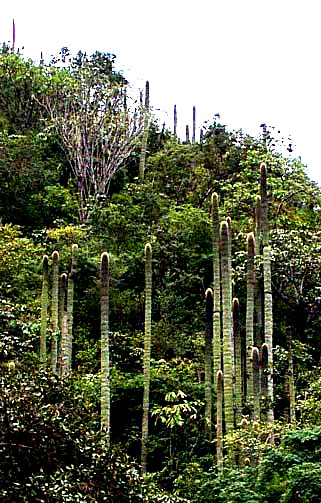Excerpts from Jim Conrad's
Naturalist Newsletter
from the October 23, 2006 Newsletter issued from Sierra Gorda Biosphere Reserve, QUERÉTARO, MÉXICO
NEOBUXBAUMIA POLYLOPHA -- ENDEMIC GIANT CACTUS

Last Tuesday afternoon Beto invited me to ride with him three or four miles from town to a certain canyon. As soon as we were a little inside the canyon I could see why he'd brought me. That's it above.
All along the limestone canyon wall, emerging majestically from the thorny forest to heights of 30 to even 40 feet, were giant cacti. They were NEOBUXBAUMIA POLYLOPHA*, with no English name. The locals call it Cardón, but they call any big, columnar cactus Cardón, and in this area there are several columnar species.
Other than the size, a striking feature of the cactus at this dusky hour was the pale halo gracing each cactus's rounded crown, where in the dimness light gathered in new thorns there. The effect was much more extraordinary than my picture portreys. I had to overexpose that picture drastically in order to show details of the cactus and other plants, and this overexposure reduced the contrast between the halos and the canyon's general gloominess.
One reason Neobuxbaumia polylophy has no well accepted common English name is that it's endemic -- in the whole world found only in Querétaro, the neighboring state of Hidalgo, and a bit of the adjoining states of Guanajuato and San Luis Potosí.
People at the Reserve are trying to scrape up about $5,000 to buy the canyon wall on which most of the giant cacti grow. Locals are removing rocks from there for building, destroying some of the habitat, so this is just one more of quite a number of urgent buying projects the Reserve is working on.